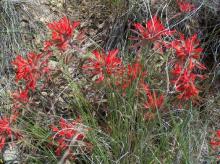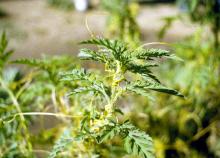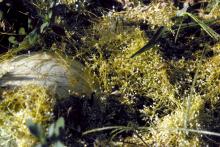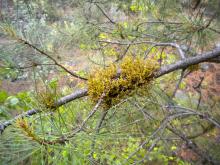There are many different kinds of parasitic plants in the Pacific Northwest. All of the known species are angiosperms (flowering plants). Gymnosperms (conifers), as far as is known, have not developed a parasitic form. Parasitic plants are found in several different families and differ widely. What they do share in common, in addition to the formation of flowers and reproduction by seeds, is the haustorium—a structure that penetrates and provides the vascular connection to the host plant.
Some of the parasitic plants have chlorophyll for photosynthesis as well as roots, stems and leaves. These plants are only partially dependent on their host for water and/or nutrition. Many are able to complete their life cycle on their own (at least in the greenhouse). These plants are sometimes called hemi-parasites or facultative parasites. Other parasitic plants do not have roots, leaves or chlorophyll. This later group is, in general, wholly dependent on the host for both water and nutrition.
This article describes the various parasitic plants found in Oregon. The following plants are covered: Bastard Toad-Flax, Bird’s Beak, Broom-rape, Dodder, Dwarf Mistletoe, Ground-cone, Indian Paintbrush, Lousewort, Owl Clover, and True Mistletoes. They are arranged in alphabetical order by common name, as is the information in the rest of this handbook. Much of the information is based on specimens located at the Oregon State University Herbarium. Although general habitat may have been recorded, host identity may be uncertain since collectors rarely collected or identified the host. In many cases, particularly for the hemi-parasites, the physical connection between the parasite and the host is difficult to find because that connection is a weak structure between roots.
Bastard Toad-Flax (Family Comandraceae)
Comandra – Perennial plants with thick, fleshy leaves and rhizomes forming haustoria that penetrate host roots. A cluster of greenish-white to purplish flowers tops the stem. Found throughout Oregon usually in hot, dry, open sites on well-drained soil in rock or sandy areas or in grasslands including savannahs. Generally, subspecies californica is found west of the Cascade Range while subspecies pallida is found east of the Cascade Range. Some overlap occurs in the Columbia River Gorge and in the Cascade Range. These plants are hemi-parasites but are not found to be a problem in agricultural systems. Hosts are rarely noted or collected. Bastard toad-flaxes are reported to be a parasite most often on sagebrush but can attach to almost any higher plant (such as aster, cottonwood, or huckleberry) with adjacent roots. Comandra species are more commonly known in pathology literature as alternate hosts for various rust diseases than as root parasites. (See also Table 1).
|
Table 1. Bastard Toad-Flax of Oregon. |
||
|
Latin Name |
Common Name |
Hosts |
|
Comandra umbellata ssp. californica |
California toad-flax |
unknown |
|
Comandra umbellata ssp. pallida |
pale bastard toad-flax |
alfalfa, locust (host collected), and sagebrush |
Birds’ Beak (Family Orobanchaceae)
Cordylanthus – Annuals that are able to flower during hot summers in arid habits. Found in coastal, southern, Cascade Range and eastern areas of Oregon. They have roots, narrow leaves, and flowers in the leaf axils or in dense terminal clusters. The roots form haustoria that penetrate the roots of nearby host plants. Its parasitic character allows it to compete in arid habits. Like Castilleja, Cordylanthus spp. can complete their life cycle without a host but are more vigorous when parasitizing hosts such as Quercus, Pinus and Helianthus and less vigorous on other hosts such as Plantago and Phleum. The hosts and effects of this parasitism have not been well investigated. There are about 5 different species found in Oregon. Cordylanthus spp. have not been a problem in agricultural systems.
Broom-rape (Family Orobanchaceae)
Orobanche – Annual or perennial, yellowish, brown or purplish root parasites that lack chlorophyll. Stems are simple or branched and fleshy; has bare scale-like leaves. Flowers racemose or solitary, white, yellow-white, or slightly purple, resembling a snapdragon. Native species of broom-rape can be found in all parts of Oregon. The most important member at the moment is O. minor (clover broom-rape), a federally listed noxious weed that has quarantine significance to many of Oregon’s trading partners. From 1923 to 1997, there have been six reports of clover broom-rape in Oregon. In 1998, clover broom-rape was identified in a single field. In 2000, clover broom-rape was found in 15 fields in Northwestern Oregon.
|
Table 2. Broom-rape of Oregon |
||
|
Latin Name |
Common Name |
Hosts |
|
Orobanche californica ssp. californica |
California broom-rape |
gumweed (Grindelia) |
|
Orobanche californica ssp. grayana |
Gray’s broom-rape |
aster, fleabane (Erigeron) and daisy |
|
Orobanche corymbosa |
flat-topped broom-rape |
sagebrush |
|
Orobanche fasciculata |
clustered broom-rape |
sagebrush, wild buckwheat, and yerba santa (Eriodictyon) |
|
Orobanche ludoviciana var. arenosa |
Suksdorf’s broom-rape |
sagebrush and other plants in the aster family |
|
Orobanche minor |
clover broom-rape |
clover, carrot and strawberry |
|
Orobanche pinorum |
pine broom-rape |
ocean spray (Holodiscus) |
|
Orobanche uniflora |
naked broom-rape |
Sedum (stonecrops) saxifrages and species in the aster family |
Clover broom-rape reproduces and spreads only by seed. One broom-rape plant produces up to 500,000 dust-like seeds that may be dispersed by wind, machinery, contaminated seed crops, animals, or clothing. Flowering plants that are hand-pulled may still mature and produce viable seed. Seed can remain dormant in the soil for 10 years or more. After germination, clover broom-rape attaches to and penetrates the root of the host plant, disrupting nutrient and water transport in the host root system. Parasitism by clover broom-rape may reduce host crop yield, and, in heavy infestations, kill the host plant.
Red clover is currently the only host in Oregon but greenhouse studies have identified several other weed and crop species that can be clover broom-rape hosts. Clover broom-rape germinated and attached to nasturtium, arrowleaf clover, subterranean clover, white clover, sweet pea, lettuce, snap bean, sunflower, and carrot. (See also Table 2).
Dodder (Family Convolvulaceae)
Cuscuta – An annual, rootless, and leafless plant that produces abundant twining stems. May be a perennial in coastal areas. It has no chlorophyll, and its leaves are reduced to scales. Cuscuta produces haustoria, which connect its yellowish entwining stems to those of its host. Clusters of small, white to cream flowers are produced. Dodder seeds are small, gray to brown, and irregularly round with a rough surface texture. They are similar to clover and alfalfa seed in density. Dodder seed can remain viable in the soil for 20 years. Once it germinates in the soil, the slender stem slowly rotates around and must contact a host or die.
|
Table 3. Dodder of Oregon. |
||
|
Latin Name |
Common Name |
Hosts |
|
Cuscuta approximata |
clustered dodder or alfalfa dodder |
alfalfa, grasses, and sagebrush |
|
Cuscuta californica var. californica |
California dodder |
composites, evening primrose, grasses, gumweed, potato, rabbit brush, tarweed and willow weed |
|
Cuscuta cephalanthi |
button-bush dodder |
aster, nightshade, sagebrush and western goldenrod |
|
Cuscuta epithymum |
common dodder |
clover |
|
Cuscuta indecora var. neuropetala |
inelegant dodder or collared dodder |
Lamb’s quarters scurf pea, and wild lettuce |
|
Cuscuta occidentalis |
western dodder |
dock, gumweed, lupine, Navarettia, Penstemon, poverty weed, strawberry, vetch, and yerba santa |
|
Cuscuta pentagona var. pentagona |
field dodder or five-angled dodder |
Bindweed, carrot, china aster, clover, cocklebur, dog fennel, Downingia, Heleochloa, ryegrass, sedge, stinging nettle, trefoil and Veronica. |
|
Cuscuta salina var. major |
saltmarsh dodder |
arrow-grass, Jaumea sp., Salicornia (glasswort or pickle-weed), and saltgrass. |
Dodder grows best in high temperatures and full sunlight. It occurs throughout Oregon in low, fresh-water, marshy areas that stay wet or moist well into the arid summer. A salt-marsh type is also found along the coast.
Dodder can be an agricultural problem where the land is low (like the Lake Labish area) or heavily irrigated. It has been a problem only on alfalfa, clover or carrot production in the late 19th and early 20th century. OSU Plant Clinic records indicate that petunia, watermelon and unspecified weeds under a cherry orchard are also hosts. Reduced host plant growth, yield, and quality losses have been reported. Aside from a few small outbreaks, dodder is considered an oddity in agricultural production. (see also Table 3)
Dwarf Mistletoe (Viscaceae)
Arceuthobium - Dwarf mistletoe species are an economically important disease of Douglas-fir in southern and eastern Oregon and of ponderosa pine, lodgepole pine, and western hemlock in much of their native ranges. Dwarf mistletoe also attacks true fir and western larch in the Cascade Range and eastern Oregon. Western larch can be seriously damaged. This mistletoe does not parasitize oak or other hardwoods. (see also Table 4)
|
Table 4. Dwarf Mistletoe of Oregon.* |
||
|
Latin Name |
Common Name |
Principal Hosts |
|
Arceuthobium abietinum f. sp. concoloris |
fir dwarf mistletoe |
grand fir |
|
Arceuthobium abietinum ssp. wiensii |
Wiens’ dwarf mistletoe |
red fir and Brewer’s spruce |
|
Arceuthobium americanum |
lodgepole pine dwarf mistletoe |
lodgepole pine |
|
Arceuthobium campylopodum |
western dwarf mistletoe |
Jeffrey pine and ponderosa pine |
|
Arceuthobium cyanocarpum |
limber pine dwarf mistletoe |
white bark pine |
|
Arceuthobium douglasii |
Douglas-fir dwarf mistletoe |
Douglas-fir |
|
Arceuthobium laricis |
larch dwarf mistletoe |
Western larch |
|
Arceuthobium monticola |
western white pine dwarf mistletoe |
western white pine and Brewer’s spruce |
|
Arceuthobium siskiyouense |
knobcone pine dwarf mistletoe |
knobcone pine and Jeffrey Pine |
|
Arceuthobium tsugense ssp. amabilae |
Pacific silver fir dwarf mistletoe |
Noble fir, Pacific silver fir and mountain hemlock |
|
Arceuthobium tsugense ssp. mertensianae |
Mountain hemlock dwarf mistletoe |
mountain hemlock |
|
Arceuthobium tsugense ssp. tsugense |
Western hemlock dwarf mistletoe |
western hemlock |
|
* Hawksworth and Wiens 1996, with additions by Mathiasen. |
||
Dwarf mistletoes are small (0.75 to 4 inches) yellowish green plants, which grow in clusters on branches of their hosts. On Douglas-fir, mistletoe plants appear scattered along slender branches of usually dense, large brooms. However, only one mistletoe plant may be present since its aerial shoots arise from an internal systemic infection. In other tree species, plant clusters arise from spindle-shaped swellings. Witches’ brooms of great variety form on all hosts.
The fruit explodes when mature; dispersing seeds several feet away. Needles of the host intercept seeds. Rain then washes seeds down to twigs, where germination and penetration occur. Once infection is established, an incubation period of 2 to 5 years passes before young shoots appear. A swelling at the point of infection usually precedes shoot production by a year or more. Pollen from male plants fertilizes flowers on female plants, which produce the fruit after several months’ development.
Dwarf mistletoes retard the growth of infected trees and cause extensive timber losses through direct and indirect mortality. Host seed production and wood quality can also be reduced. Decay fungi may gain entrance at the site of the mistletoe attachment.
Ground-Cone (Family Orobanchaceae)
Boschniakia – Short, fleshy stems that lack chlorophyll. The stem forms a large tuber-like swelling where it attaches to the host. The yellow or dark red leaves are closely overlapped. Dense spike-like clusters of flowers are produced in the axils of upper leaves. The thick, non-green plants resemble a conifer cone. Found only west of the Cascade Range, they are not an agricultural problem.
|
Table 5. Ground-Cones of Oregon. |
||
|
Latin Name |
Common Name |
Hosts |
|
Boschniakia hookeri |
small ground-cone |
salal (the most common host), kinnikinnick, and madrone |
|
Boschniakia strobilacea |
California ground-cone |
madrone and manzanita |
Indian Paintbrush (Family Orobanchaceae)
Castilleja – Perennial herbaceous plants found throughout Oregon from the beaches to the mountains. They have roots, narrow leaves and flowers in a terminal raceme or spike bearing large, leaf-like brightly colored bracts. The roots form haustoria that infect the roots of nearby host plants.
Herbarium specimens provide little information about hosts. Indian Paintbrushes parasitize a wide variety of hosts ranging from grasses and legumes to trees, including hosts not in their native range. Although they can complete their life cycle on their own, they are much more vigorous when growing on a host. Some research has shown that when grown with the host some Indian Paintbrushes are 2 to 41 times taller, branch more, and flower earlier. Leguminous plants have been shown to be a more beneficial host than grasses. The host type also affects root biomass of the parasite. They probably normally live on a host in nature.
Although growth of the host is reduced when parasitized, the amount of reduction is dependent on the host/parasite combination. Parasitized hosts produced 24% to 71% less aboveground biomass than did unparasitized hosts. The total biomass of the parasitic association is less than the total of each grown separately.
There are about 38 different species of Indian Paintbrushes found in Oregon. Very few have been closely associated with hosts except for C. arachnoidea on Polygonum shastense, C. miniata ssp. miniata and C. thompsonii on sagebrush, and C. parviflora var. oreopola on Luetkea pectinata (partridge foot).
Owl Clover (Family Orobanchaceae)
Orthocarpus – Annual herbaceous plants with roots, narrow leaves, and flowers in terminal spikes bearing large leaf-like, brightly colored bracts. Found sporadically around western and eastern Oregon from the plains to the mountains. Growth and host relations seem to be similar to Castilleja. Hosts have rarely been investigated. There are about 5 different species found in Oregon.
Triphysaria (Family Orobanchaceae)
Many of these used to be in the genus Orthocarpus and have similar growth habit and parasitic characteristics. These plants are usually found in meadows and grasslands of western Oregon. Hardly any information exists on the hosts. There are about 3 different species found in Oregon.
Lousewort (Family Orobanchaceae)
Pedicularis – Perennial herbaceous plants with roots, stems and leaves. Flowers have a two-part corolla with the upper lip highly arched or hooded. Typically found in the Cascade Range and mountains of eastern Oregon. Very little information exists with regard to their parasitic nature. There are about 8 different species found in Oregon.
True Mistletoe (Viscaceae)
Native species of Phoradendron can be found throughout Oregon. Mistletoe of oak and juniper are the most common. (see also Table 6)
Phoradendron villosum is parasitic on white oak (Quercus garryana), black oak (Q. kelloggii), occasionally on manzanita, and a few other western hardwood species. This mistletoe does not grow on conifers. It is a large, green plant with somewhat hairy leaves. Stems are green and dichotomously (forked) branched. Plants usually are widely scattered on a branch but may form large brooms. Flowers are inconspicuous and fruits are shiny, whitish berries. Mistletoe derives water, mineral nutrients, and some organic nutrients from the xylem of the host but most of its organic nutrients come from its own photosynthesis.
Heavily infected hosts are weak and grow slowly. Weakened trees may be predisposed to insect attack and may succumb during drought or other adverse conditions. Branch and trunk swellings are frequent. Branches heavily laden with mistletoe often break off in storms or high winds; property damage may result.
|
Table 6. True Mistletoes of Oregon. * |
||
|
Latin Name |
Common Name |
Hosts |
|
Phoradendron densum |
dense mistletoe |
Western juniper |
|
Phoradendron juniperinum |
juniper mistletoe |
Western juniper |
|
Phoradendron libocedri |
incense cedar mistletoe |
incense cedar |
|
Phoradendron villosum |
oak mistletoe |
Oregon white oak, California black oak and red oak in cities. |
|
* Hickman 1993. |
||
Phoradendron juniperinum is parasitic on juniper. Mature stems are woody with smooth surfaces. Leaves are scale-like and about 1 mm long. Flowers are produced from July to September. The male inflorescence has one or two segments; each with five to nine flowers. The female inflorescence has one segment with two flowers. Fruits are pinkish white and smooth and are about 4 mm in diameter. Fruits can be toxic to humans and livestock.
Birds such as robins and blue jays eat and spread seeds of Phoradendron spp. to other trees. Seeds pass through the bird’s digestive tract but retain a sticky covering of threads. Once deposited on a branch, the seed germinates and infects small branches of a suitable host. The resulting plant produces many seeds that continue to infect the same host. Mistletoe may increase dramatically within a single tree where birds feed on berries, roost, and congregate. Seeds may be toxic to humans if eaten.
Considerable folklore and legend surrounds the properties of mistletoes. Based on these beliefs mistletoes have been used for evoking spiritual powers, as medicine, to promote fertility, and for good fortune. Many of these uses are associated with other genera of mistletoe such as the European mistletoe Viscum album. Similar uses of Phoradendron in the Pacific Northwest are likely due to European ancestry and culture of the settlers. The origin of the custom of kissing under mistletoe is not known but may be associated with aspects of good fortune and fertility. There are no known replicated trials investigating these properties.
Parasites of the Parasites
Even plant parasites can have plant parasites. They are not economically damaging or used as biological controls, but they can harbor pathogens that are important on other crops.
Comandra (Bastard Toad-Flax) can serve as the alternate host for several rusts including Cronartium comandrae, which is involved with a canker of lodgepole and ponderosa pines in the Pacific Northwest, and Puccinia andropogonis, which is involved with a rust on a grass. Puccinia comandrae is an autoecious rust on this host.
An anthracnose fungus, Colletotrichum destructivum, has been reported on several dodder species in Oregon. Indian Paintbrushes have their share of leaf spots, powdery mildews, and rusts. Orthocarpus has an Ascochyta leaf spot and a downy mildew (Peronospora sordida) has been reported.
Several diseases have been reported on Dwarf Mistletoes. Anthracnose (Colletotrichum gloeosporioides) causes lesions and dieback of the shoots. Cylindrocarpon gillii produces girdling lesions on the shoots that erupt with masses of white spores. Caliciopsis arceuthobii infects stigmas during pollination and replaces the stigma and fruit with a black stroma of Pestalotia maculiformans, where the seed should have been produced.
Dodder has been used to transmit viruses from one host plant to another in cases in which the virus is difficult to study or move to differential hosts for identification. The dodder is just used as a living bridge between the hosts. Broom-rape, however, is a host for Cucumber mosaic virus and may be a host for several others. The virus can be acquired from the broom-rape’s host.
Management
Some parasitic plants are of economic concern for agriculture and/or forestry. Management generally includes some aspect of eliminating, removing or managing the host plant either physically or chemically. Seed lots can be examined or tested for purity to prevent transport of problems such as dodder and broom-rape. Silvicultural tactics are used for mistletoe management and include thinning, selective harvests, overstory management, removal of brooms from individual trees and favoring non-hosts. See Section 4 for more information.
References
Chuang, T. and Heckard, L.R. 1971. Observations on root-parasitism in Cordylanthus (Scrophulariaceae). American Journal of Botany. 58:218-228.
Gal-On, A., Naglis, A., Leibman, D., Ziadna, H., Kathiravan, K., Papayiannis, L., Holdengraber, V., Guenoune-Gelbert, D., Lapidot, M., and Aly, R. 2009. Broomrape can acquire viruses from its hosts. Phytopathology 99:1321-1329.
Geils, B.W., Cibrián Tovar, J., and Moody, B., tech. coords. 2002. Mistletoes of North American Conifers. Gen. Tech. Rep. RMRS–GTR–98. Ogden, UT: U.S. Department of Agriculture, Forest Service, Rocky Mountain Research Station. 123 p.
Hawksworth, F.W. and Wiens, D. 1996. Dwarf Mistletoes: Biology, Pathology and Systematics. Agricultural Handbook 709. Washington, DC: USDA Forest Service.
Heckard, L.R. 1962. Root parasitism in Castilleja. Botanical Gazette. 124:21-29.
Hickman, J.C. (ed.). 1993. The Jepson Manual: Higher plants of California. University of California Press, Berkeley.
Hitchcock, C.L., and Cronquist, A. 1976. Flora of the Pacific Northwest: Third printing with further corrections. University of Washington Press, Seattle.
Kuijt, J. 1969. The biology of parasitic flowering plants. University of California Press.
Malcolm, W.M. 1966. Root parasitism of Castilleja coccinea. Ecology. 47:179-186.
Mallams, K. M. and Mathiasen, R. L. 2010. Mistletoes on Hardwoods in the United States. USDA Forest Service Forest Insect and Disease Leaflet 147. 12 pp.
Mathiasen, R.L.; Nickrent, D.L.; Shaw, D.C. and Watson, D.M. 2008. Mistletoes. Pathology, Systematics, Ecology, and Management. Plant Disease 92:988-1006.
Matthies, D. 1997. Parasite – host interactions in Castilleja and Orthocapus. Canadian Journal of Botany. 75:1252-1260.
Piehl, M.A. 1965. Natural History and Taxonomy of Comandra. Memoirs of the Torrey Botanical Club 22:1-97.
Whitson, T.D. (ed.) 1991. Weeds of the West. Western Society of Weed Science and University of Wyoming.







